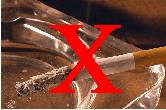
WEDNESDAY, Nov. 16 (HealthDay News) — As thousands of smokers across the United States try to kick their bad habit as part of the Great American Smokeout on Thursday, experts agree that a two-pronged strategy is the best bet for success.
“The U.S. Public Health Service has twice done very extensive reviews of all the evidence, and [best] is a combination of counseling/advice, by pharmacists, physicians or quitlines, plus medicine,” said Thomas Glynn, director of cancer science and trends and of international cancer control for the American Cancer Society.
A lot has changed since 1976, when the first smokeout took place, Glynn noted. “People could smoke on airplanes and in restaurants; the person sitting next to you in the movie theater could be smoking. Two of every five people smoked; now it’s one of five.”
Another difference: “Now, there are a number of ways that people can succeed, [including] seven medications approved by the FDA [U.S. Food and Drug Administration],” he said.
Still, many Americans resist medications or counseling, and rely on personal willpower to get them through nicotine withdrawal.
“Cold turkey, sheer willpower; the best data is that about 5 percent of people succeed,” said Dr. Norman Edelman, chief medical officer at the American Lung Association.
“People who smoke 10 cigarettes a day, light smokers, if they want to try quitting on their own, that’s fine,” said Gary Giovino, chair of the department of community health and health behavior at the University at Buffalo, State University of New York. For heavy smokers, he recommends starting with nicotine replacement therapy.
Smoking-cessation medications come “in three buckets: nicotine replacement, Wellbutrin/Zyban (bupropion) and Chantix (varenicline),” said Dr. Nancy Rigotti, director of the tobacco research and treatment unit at Massachusetts General Hospital in Boston. “They all work. It’s better to take one than none.”
Nicotine patches give users a steady dose of nicotine through the skin and come in 16- or 24-hour varieties, by prescription or over-the-counter. Fast-acting forms of nicotine replacement therapy are lozenges and gum, available over-the-counter, and prescription inhalers and nasal sprays.
“You use the patch to get constant coverage and use the other forms to get over cravings, as supplements,” Rigotti said.
In its 2008 recommendations, the U.S. Agency for Healthcare Research and Quality advised clinicians to consider nicotine patches in combination with Wellbutrin or Zyban for smokers unable to quit with a single type of medication. Wellbutrin, Zyban and Chantix all carry black box warnings about the increased possibility of suicidal thoughts, although Chantix has come under the most scrutiny for this potential side effect.
“The fear is of big changes in behavior,” Giovino said. “The question is, does it happen more often with Chantix or if you stop smoking with a nicotine replacement drug?”
“If people want something based on a prescription, they should discuss it with their doctor,” Giovino said.
Telephone quitlines can be effective, convenient and free, but are underused because smokers have misconceptions about them, Rigotti and Giovino said.
“It’s like getting a phone appointment with your doctor,” Rigotti said. “They’ll schedule calls around your quit day. It’s so you can talk to somebody who can help you if you’ve slipped, you can get back on the wagon. It’s practical information, not psychotherapy, not voodoo.”
Smokers can call 1-800-QUIT-NOW from anywhere in the United States, and some state quitlines offer free nicotine replacement therapy.
Internet quit sites provide another option. For instance, the American Lung Association offers the “Freedom From Smoking” online program, Edelman noted.
Even with outside help, willpower still comes into play in breaking long-held habits and battling sharp cravings.
Giovino suggested the “‘six Ds’: delay, drink water, distract yourself, discuss with someone, deep breath and, finally, don’t debate. People who do best are those who decide smoking is no longer an option.”
More information
Visit the American Legacy Foundation website for help to quit smoking.

